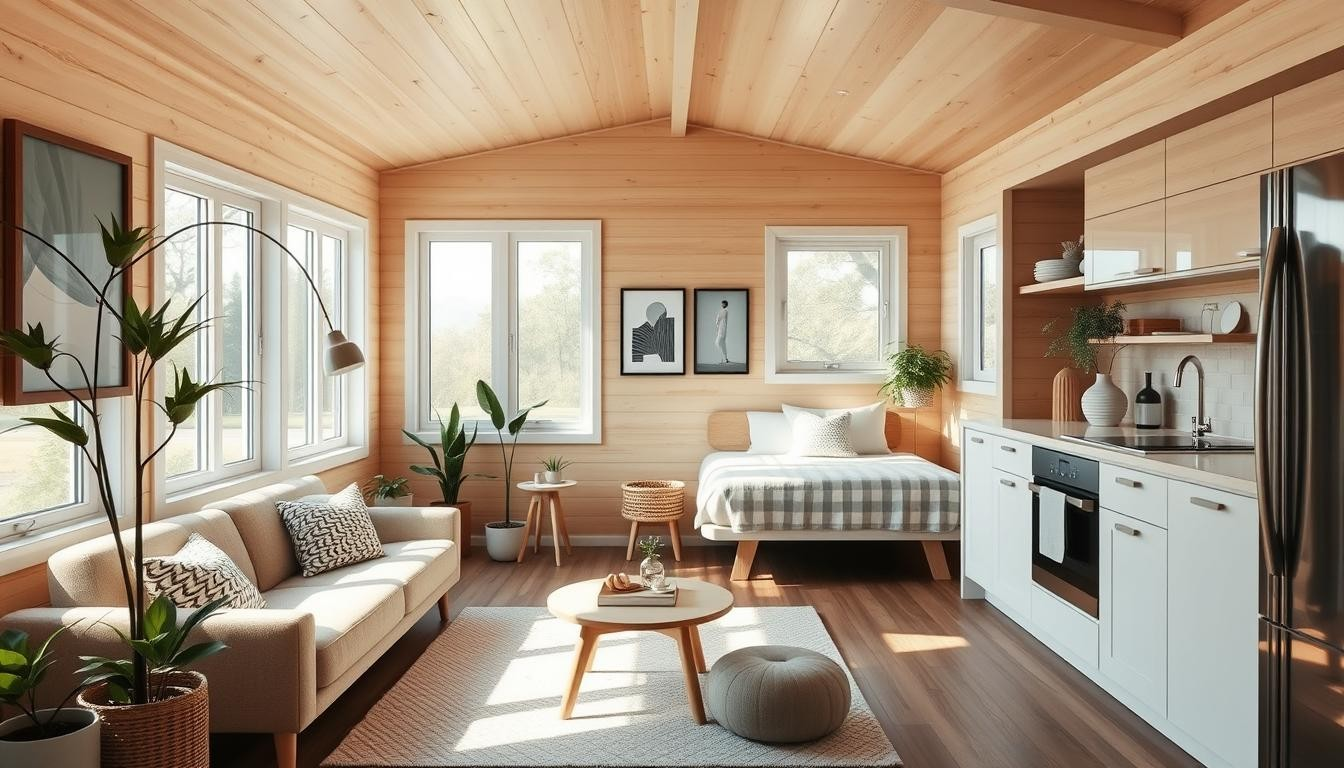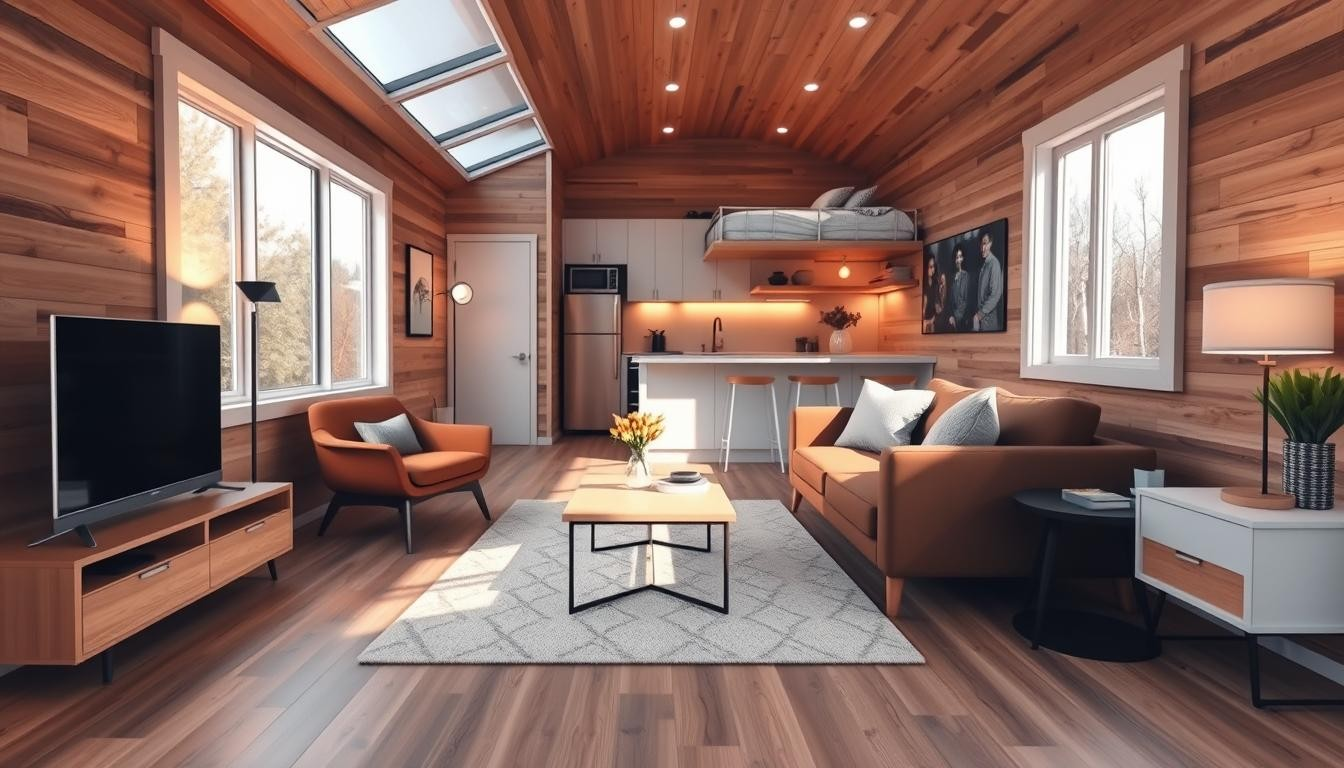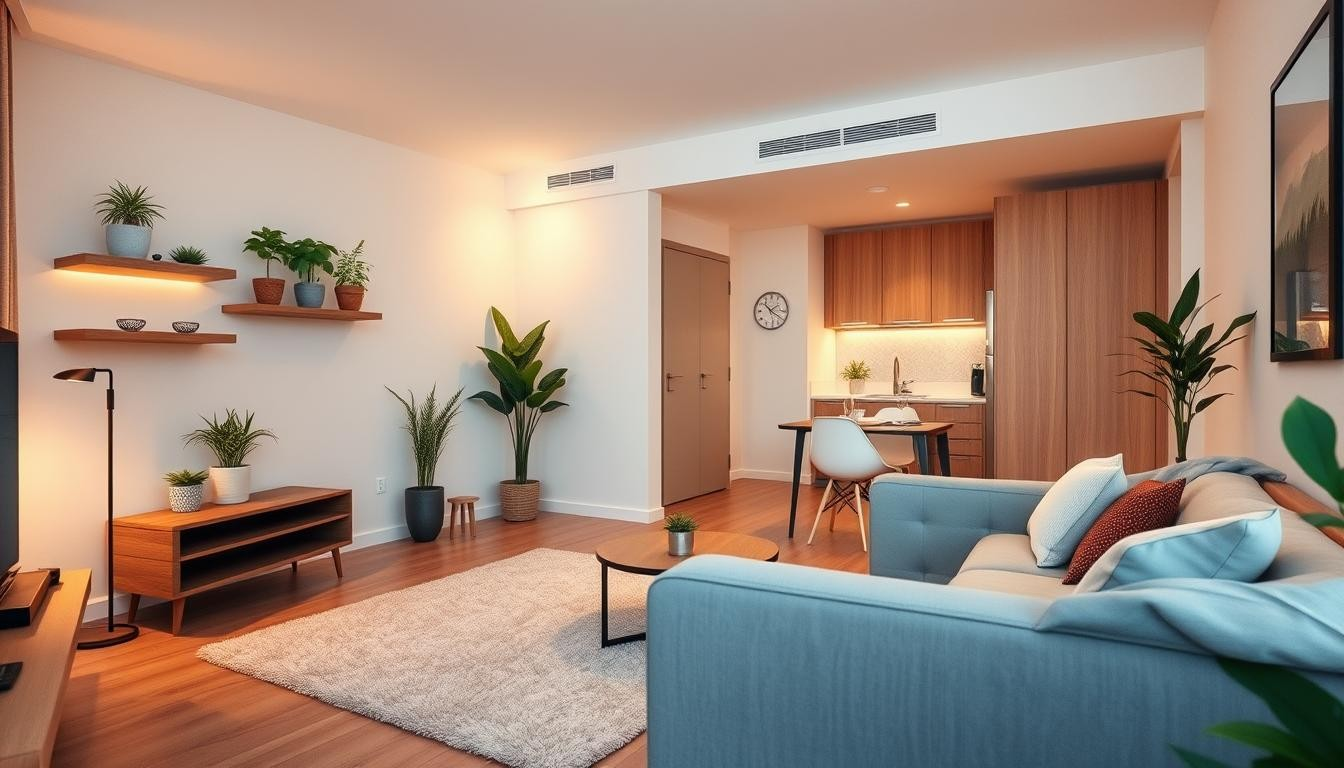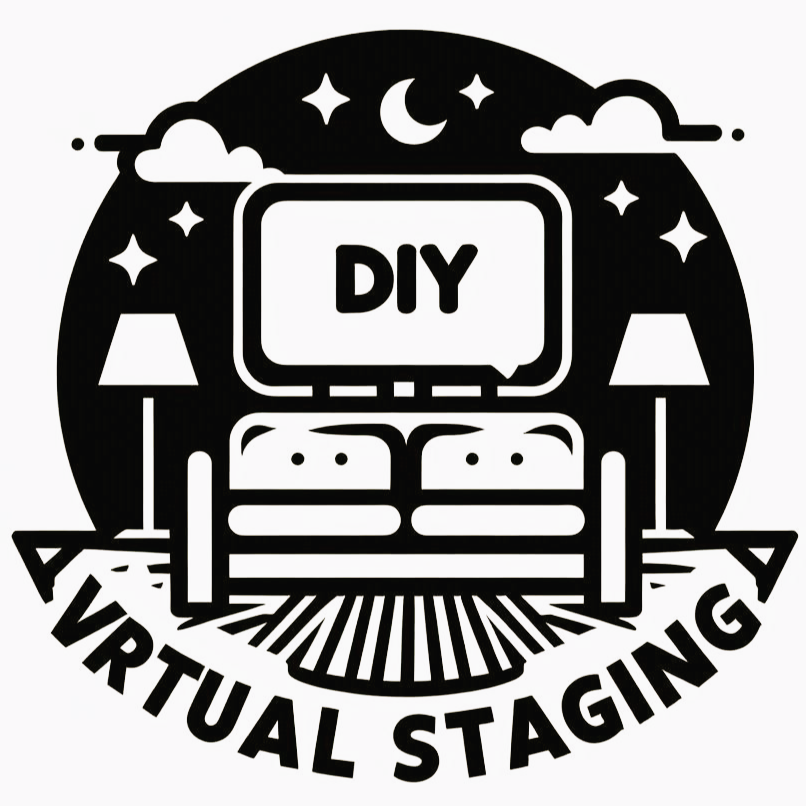Virtual Staging for Tiny Homes: Big Appeal in Small Spaces
The tiny home movement is growing fast in the United States. Virtual staging for tiny homes is key for homeowners and real estate agents. It lets people see how a small space can become cozy and functional.
This is where tiny home virtual staging shines. It shows the potential of a small space interior design to potential buyers.

Virtual staging makes tiny homes more appealing. It's vital in the competitive real estate market. A well-designed small space can be a major selling point.
With virtual staging, the possibilities are endless. The benefits are many.
Introduction to Virtual Staging
Virtual staging for tiny homes is a game-changer. It's crucial for the real estate industry. Understanding its benefits and techniques is essential.
As we explore tiny home virtual staging, we see its power. It creates beautiful and functional small space designs.
Key Takeaways
Virtual staging for tiny homes is a crucial tool for homeowners and real estate agents.
Tiny home virtual staging can help create a big appeal in small spaces.
Small space interior design is a major selling point in the competitive real estate market.
Virtual staging for tiny homes can help potential buyers visualize the full potential of a compact living space.
Virtual staging for tiny homes is a cost-effective and efficient way to showcase a property's potential.
Virtual staging for tiny homes can be used to create a variety of different designs and styles.
Understanding Virtual Staging for Tiny Homes: Creating Big Appeal in Small Spaces
Virtual home staging services are now a big hit in real estate, especially for tiny homes. They offer a budget-friendly and quick way to show off a property's potential. This makes it more appealing to potential buyers. Homeowners and agents can use virtual staging to show off a tiny home's best features and make it seem bigger.
Virtual home makeover uses special software to add virtual furniture and decor to photos. This makes the property look welcoming and real. It's great for tiny homes because it helps buyers see the space in a more useful and attractive way. Some key benefits include:
Increased online engagement and views
Improved perception of space and functionality
Enhanced visual appeal and aesthetic
Using virtual home staging services can make a tiny home more appealing online. This can lead to more interest and sales. If you're selling a tiny home or want to boost its online appeal, virtual staging is a good choice.
The Benefits of Virtual Staging in Compact Living Spaces
Virtual staging is a big help for home staging for small spaces. It lets homeowners and real estate agents show off tiny homes' potential without spending a lot. With virtual furniture staging, you can make small spaces look bigger and more flexible. This makes them more attractive to people looking to buy or rent.
Virtual staging in small spaces has many benefits. Some of the main advantages are:
Time and cost savings: It cuts down on the time and money needed for marketing and ads.
Increased appeal: It makes spaces look bigger and more flexible, drawing in more buyers and renters.
Flexibility: It's easy to change designs and layouts, letting you try out different styles.
For interior design for small homes, virtual staging is a great chance to try out different layouts and designs. You can do this without making any real changes. This is super helpful for those who want to get the most out of their small space.
Overall, virtual staging is a powerful tool for showing off tiny homes and small living spaces. By using its benefits, homeowners and real estate agents can make their properties more appealing. This helps attract more buyers and renters.
Digital Transformation: How Virtual Staging Revolutionizes Tiny Home Marketing
Virtual staging for tiny homes is changing the real estate game. It makes small spaces look big. Homeowners and agents use digital tech to make tiny homes more appealing. This new way of presenting homes is a big step up from old methods.
Virtual staging saves money and time. It lets homeowners show off their homes in different styles. This is a smart and quick way to market tiny homes.
Increased online engagement and visibility
Improved buyer experience and interaction
Enhanced property presentation and showcase
Faster sales and reduced marketing time
By using virtual staging, tiny home owners and agents can lead the market. They make the most of small spaces, attracting more buyers.
Essential Virtual Staging Techniques for Small Spaces
Creating a sense of spaciousness is key in virtual home staging. High-quality visuals and highlighting the home's best features are essential. Virtual staging for real estate is popular because it lets buyers imagine themselves in the space. A virtual makeover can make a room more welcoming and functional.
Lighting, color, and texture are vital in virtual staging. Proper lighting can make a room feel bigger. Color sets the mood, and texture adds depth. Furniture and decor are crucial for a welcoming space. Virtual staging software lets users try out different designs easily.
Some key techniques for virtual staging include:
Using minimal furniture to create a sense of openness
Adding decorative elements to create visual interest
Utilizing virtual staging software to experiment with different layouts and designs
These techniques help make small spaces feel larger and more inviting. Virtual staging is useful for any property size. With the right makeover, you can attract more buyers.

Maximizing Visual Space Through Virtual Design
Interior design for small homes focuses on making the most of space. Virtual furniture staging can make tiny homes look bigger and more inviting. It lets homeowners try out different layouts and furniture setups to use space wisely.
Color psychology is key in making small spaces feel bigger. Light colors and neutral tones can make a room appear larger. Monochromatic color schemes help keep a small space looking cohesive.
Strategies for Maximizing Space
Use multi-functional furniture to reduce clutter and increase storage space
Create a sense of flow by placing furniture in a way that guides the eye through the room
Minimize clutter by using storage containers and keeping surfaces clear
By using these strategies in virtual furniture staging, homeowners can make their tiny homes more attractive. It's all about creating a sense of flow and functionality. Virtual design tools are great for achieving this.
Virtual furniture staging and maximizing space in tiny homes can draw in more buyers. Whether you're selling your tiny home or designing a space, virtual design tools can help you succeed.
Design Element | Benefits |
|---|---|
Light colors | Make a room feel larger |
Multi-functional furniture | Reduce clutter and increase storage space |
Minimizing clutter | Create a sense of flow and functionality |
Technology and Tools in Tiny Home Virtual Staging
Virtual staging for tiny homes is getting more popular. Thanks to technology and tools, creating stunning virtual stagings is easier than before. It lets homeowners show off their small spaces in a unique and appealing way.
One key tool is virtual staging software. It lets users make high-quality visuals and customize designs to fit their needs. This software is flexible and cost-effective.
It also comes with features like 3D modeling tools and interior design apps. These help users create a more realistic and immersive experience. For example, they can make a virtual tour of their tiny home. This lets potential buyers explore the space remotely.
Technologies like virtual reality and augmented reality are also used. They create a fully immersive experience. Users can explore and interact with the virtual space in a more engaging way.
The use of technology and tools in virtual staging has changed how we showcase and market small spaces. It makes it easier for homeowners to sell their properties. And for buyers to find their dream home.

Customizable designs and layouts
High-quality visuals and 3D modeling tools
Interior design apps and virtual reality capabilities
Cost-effective and flexible solutions
These features make virtual staging software a must-have for anyone wanting to showcase their tiny home. It highlights the potential of small space interior design through tiny home virtual staging.
Professional Tips for Virtually Staging Tiny Homes
Virtual staging of tiny homes requires careful planning. Lighting optimization is key to making a room look bigger and more welcoming. You can use natural light, artificial light, and lighting effects to achieve this.
Virtual staging services can also improve a room's lighting. This makes the space more appealing to potential buyers.
Scale and proportion are also important in virtual staging. The right furniture and decor can make a space feel larger and more harmonious. A virtual makeover can offer a fresh view of the space.
Here are some tips to consider:
Use multi-functional furniture to maximize space.
Select furniture that is proportional to the room size.
Consider the style and aesthetic of the space when choosing decor.
By following these tips and using virtual home staging services, you can create a beautiful space.
Common Mistakes to Avoid in Small Space Virtual Staging
When staging small spaces, it's key to avoid overcrowding. This can make a room feel tight and unwelcoming. To fix this, use virtual furniture staging to make the space feel open and simple.
In small homes, picking the right furniture size is vital. The wrong size can shrink a room even more. Choose furniture that fits well and leaves room for airiness.
Here are some mistakes to steer clear of in small space virtual staging:
Overcrowding the space with too much furniture
Using furniture that is too large for the space
Not leaving enough negative space to create a sense of flow

Avoiding these errors and using virtual furniture staging can make a small space look bigger and more inviting. Keep your design simple, minimal, and in scale with the room. This will bring harmony and balance to your space.
Success Stories: Before and After Virtual Staging Transformations
Virtual staging for tiny homes has changed how we show and sell small spaces. It makes small areas look bigger and more appealing. This is key for real estate agents, homeowners, and designers.
Many success stories show how virtual staging boosts tiny home appeal. For instance, a tiny home in California was staged virtually. It looked more spacious and modern. This led to more interest and a quick sale.
Some benefits of virtual staging for tiny homes include:
Cost-effective marketing solutions
Enhanced visual appeal
Faster property sales
These benefits come from virtual staging's ability to make spaces look bigger. It also offers design flexibility and is cost-effective. This way, it helps showcase tiny homes' potential and attracts more buyers.
In conclusion, virtual staging for tiny homes is a game-changer. It makes small spaces look bigger and more appealing. With its cost-effectiveness, visual appeal, and quick sales, it's a must-have for selling or designing tiny homes.
Conclusion: Embracing the Future of Tiny Home Presentation
The tiny home movement is growing fast. Virtual staging is a key tool in changing how these small homes are shown and sold. Virtual staging for tiny homes lets homeowners and real estate agents show off these homes' full potential. They can create designs that make the space look bigger and more functional.
The future of tiny home virtual staging looks promising. It's a cost-effective way to make these homes more appealing. With technology, small space interior design experts can create experiences that excite buyers. This helps them see the possibilities in even the smallest spaces.
As more people want tiny homes, using virtual staging will be crucial. It helps show the charm and versatility of these small homes. This way, homeowners and real estate agents can open up new chances in the tiny home market.
